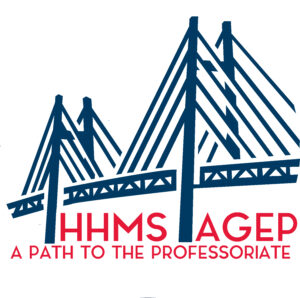The objectives for implementing the HHMS-AGEP Model are to:
- Increase teaching self-efficacy and develop a strong faculty identity in historically URM-STEM doctoral students;
- Significantly increase the number of URM-STEM doctoral students interested in pursuing academic careers;
- Add to the theoretical and research knowledge base on URM doctoral students’ pathways to the professoriate through the conduct of a program of social science research and,
- Conduct an external evaluation and self-study to determine the effectiveness of the AGEP HHMS Model in meeting its stated goals and objectives.
Development and Implementation of the Model
The HHMS-AGEP Model creates an authentic context-based learning experience by following a curriculum of faculty preparation that integrates theoretical knowledge gained in the classroom, with the practical experience obtained during a cognitive teaching apprenticeship at a community college. Grounded in the Social Cognitive Career Theory (SCCT), the conceptual framework of the Model builds on the synergy unlocked by the three cognitive variables __ self-efficacy, outcome expectations, and goals. The SCCT proposes that it is the interplay of three cognitive variables that regulate individual career development, and, when learning and external social factors positively correspond to students’ perceptions of themselves and their strengths, it becomes increasingly more probable that individuals will pursue career goals in line with their learning. The Model relies on a stepwise approach to develop teaching self-efficacy, building on a series of interventions that maximizes the opportunities for successful personal learning experiences, while minimizing the possibility of discouraging failures. The personal growth achieved at prior steps serves to prepare the student to reap the maximum benefits of each subsequent step. Initially, first and second-year doctoral students participate in Level I basic engagement activities such as seminars, webinars, and/or workshops (non-credit hours) that are primarily designed to inform and stimulate interest in an academic career. After students complete their disciplinary coursework, and enter into their dissertation phase of their studies, they proceed to Level II (years 3-4) medium engagement activities, which includes credit-based courses designed to increase pedagogical knowledge and understanding of the full range of faculty roles and responsibilities. Upon completion of Level II activities, the training culminates with Level III (years 4-5) activities which include an individualized mentored teaching experience at a community college. During this cognitive apprenticeship, students will acquire discipline specific pedagogical skills and become socialized into the professoriate. This scaffolding approach maximizes the opportunities for success, while minimizing the possibility of failures – key tenets of the SCCT. Students who complete Levels II and III are also eligible to participate in the Diversifying the Professoriate Institute, a three-day conference that prepares advanced graduate students for the professoriate through a series of lectures, workshops, and networking opportunities with mentors and potential employers.
Hypotheses to be Tested
We hypothesize that selected institutional, cognitive, and cultural factors will lead URM STEM doctoral students to increase interest in a faculty career that will, in turn, lead to increased commitment to, and preparation for, entry into the academy.
Methods to be Used
The Doctoral Student Survey (DSS), including researcher developed items and existing or adapted scales, will be used. Collectively, the items on the DSS will assess the social-cognitive, cultural, and personal factors of interest. For example, sample Likert-type items to assess faculty professional identity include: (a) “I feel like I can be a successful member of the professoriate,” and (b) “Being a member of the professoriate is important to me.” A scale that will be modified to better reflect STEM doctoral students and environments at the university level is The College Teaching Self-Efficacy Scale (1). The DSS is planned for the spring semester beginning the first full year of the project and each subsequent spring semester. An invitation will be sent to all STEM doctoral students (approx. 300 students) at participating institutions to complete the DSS. There will also be pre- and post- surveys of Level III students (approx. 45) students focusing more specifically on students’ discipline-specific pedagogical knowledge, attitudes, and skills. Additionally, a case study and three focus groups with selected students will be done.
Strategies for Quantitative Data Analyses
We will compute descriptive statistics to characterize and summarize the sample. All scales will be scored, resulting in calculations of means, SDs, and reliability coefficients. Bivariate analyses and ANOVAs will be performed to test relationships and differences. Further, we will test a regression model, with personal/background, social-cognitive, cultural, and institutional factors as the predictors, and URM STEM doctoral students’ intentions to pursue and remain in the professoriate as the outcome variables. Since the empirical research on gender and ethnic differences (e.g., U.S. born vs. non-U.S. born Black) among HBCU STEM doctoral students is virtually nonexistence, we will also examine whether observed effects differ by gender or across racial ethnicity, and if there are interaction effects of ethnicity and gender.
Details on Qualitative Analyses
We will use a strengths-based qualitative approach focusing on HBCU STEM doctoral students’ experiences, efficacy, faculty professional identity, environmental barriers/supports, and outcome expectations. The qualitative analysis will follow Creswell’s guidelines (2) that involve examination, aggregation, and interpretation of textual data leading to the identification of themes and patterns that will permit interpretations and increase our understanding of the results. Ultimately, the qualitative data will be analyzed with emergent coding methods guided by the SCCT theoretical framework and the overarching research questions. This work is not intended to be generalizable, but instead, to highlight how the HBCU context, self-efficacy, and faculty identity may influence HBCU STEM doctoral students’ persistence and career interests and intentions.
References
- Prieto, L. (2006). College Teaching Self-Efficacy Scale. Retrieved from https://www.uky.edu/~eushe2/Pajares/CTSES-Prieto2006.pdf
- Creswell, J. (2009). Research design: Qualitative, quantitative, and mixed methods approaches (3rd ed.). Los Angeles: Sage.
- Connolly, M. R., Savoy, J. N., Lee, Y.-G., & Hill, L. B. (2016). “Building a better future STEM faculty: How doctoral teaching programs can improve undergraduate education”. Madison, WI: Wisconsin Center for Education Research, University of Wisconsin-Madison.
- Bettinger, E. P., Long, T. L., G& Taylor., E. S. (2016). “When inputs are outputs: The case of graduate student instructors”. Economics of Education Review 52:63-76.
- Feldman, Kenneth A. “The Superior College Teacher from the Students’ View.” Research in Higher Education, vol. 5, no. 3, 1976, pp. 243–288. JSTOR, www.jstor.org/stable/40195219. Accessed 18 May 2020.

